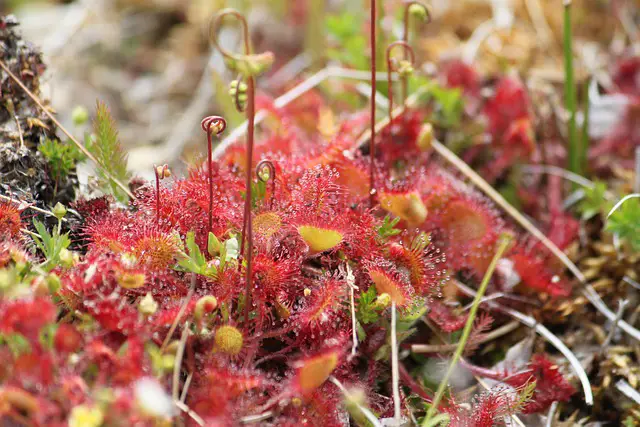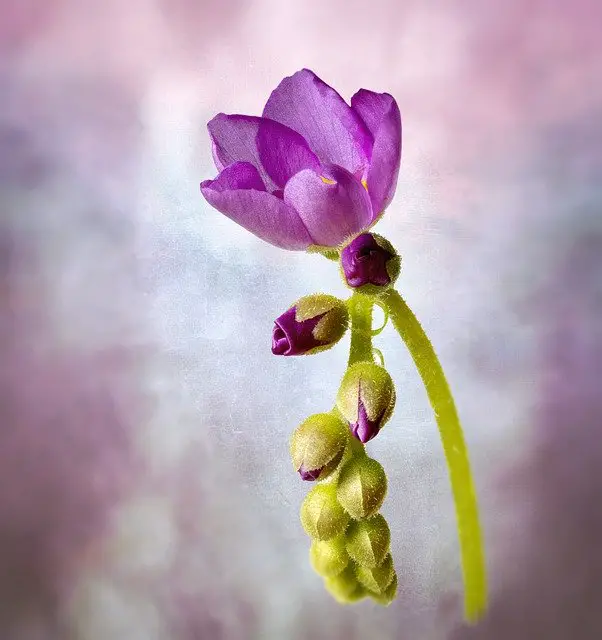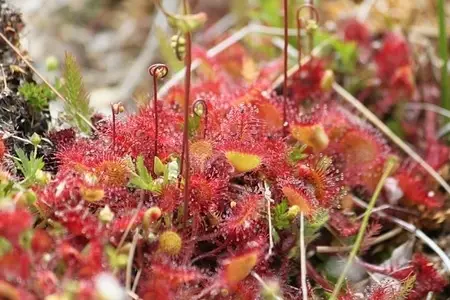Your sundew is flowering. It is an exciting time! But, what should you do now? is it safe to let your sundew flower?
It is safe to let sundews flower. Sundews can flower multiple times before experiencing a slowdown in growth. Depending on your individual goals, you must decide if prioritizing your sundew’s growth or collecting seeds.
I own several sundews, and they have flowered multiple times. After lots of research on the subject of flowering plus my personal experience, I decided to write this article. I will explain the best strategies to keep your sundew healthy during the blooming process.
Should I Cut the Flower off My Sundew?
It is not uncommon for Drosera to produce flowers. Sundews can produce multiple flower year round.
When they start growing the flower stalks, you must decide whether you cut the flower stalks or let them continue to grow.
For other carnivorous plants, it is highly recommended to stop the flowering process. For example, Venus flytraps tend to lose tons of energy with the flowering cycle. Letting your plant flower means slowing down their growth substantially for the whole season. However, sundews do not undergo the same effect when they bloom.
Sundews do not die due to the flowering process. The plant employs some energy to produce flowers, but the process won’t kill it or slow down its growth significantly. It is entirely safe to let your drosera flower.
If you are interested in propagating your sundew by collecting seeds, feel confident about letting your sundew flower. However, I recommend letting your sundew flower enough to collect the seeds but consider cutting flower stalks you do not need.
When sundews flower multiple times in a short period of time, their growth can start slowing down. For that reason, it is not always recommended to let your sundew flower continuously.
For best results, allow your sundew to flower once or twice to collect seeds, but consider cutting off any other flower stalks. The flowering process can be exhausting for the plant if it repeats multiple times throughout the season.
I personally feel confident about letting my sundew flower because I am interested in collecting seeds. But, one flower stalk tends to be enough. Each stalk usually develops multiple flowers. So, from a single flower stalk, you can collect dozens of seeds.
Here is a summary of the best strategies on the flowering process:
| Situation | Recommendation |
| You are NOT interested in seed collection | You can cut off the flower stalks to save some of your plant’s energy. Still, if you want to see the flowers, it is safe. You can let them grow if you are curious. |
| You want more sundews | Let your plant flower once or twice and you should be able to collect plenty of seeds. Once you have enough, you can cut off all the future flower stalks. |
| You do NOT want more sundews | If your space is limited, more sundews might be a bit of a hassle. In that case, cut off all flower stalks, sundews propagate easily and can take over like weeds. |
Keep on reading this article to get more details about the flowering process and how to propagate your sundew.

Sundews flowering 
A typical Sundew flower
How to Remove Sundew Flowers Stalks
Removing the flower stalks from your sundew is an easy process.
As soon as you spot a flower stalk growing out of your sundew, use a sharp pair of scissors to cut it off.
You can cut off the stalk close to the center of the plant, but while you do it, make sure you do not damage any surrounding leaf.
For best results, cut the flower stalk off as soon as you spot them. Letting the flower stalk grow minimizes the positive effects of removing the stalks.
The Sundew Flowering Process
Not everyone is aware that sundews flowers. Because of their carnivorous nature, the flowering process in sundews is sometimes a surprise.
Some sundews flower year-round, while others only flower seasonally. Sundews produce long flower stems which develop multiple flowers. The flowers grow well above their leaves and keep pollinators away from their deadly tentacles.
Many sundews self-pollinate. Self-pollination means that plant mechanisms ensure the flowers pollinate independently without the need for any external help.
Collecting seeds from self-pollinating sundews is very easy. You just let your plant grow its flower. Then, when the flower dries up, you can collect the seeds from the dried-up flowers.
The condition of your sundew can influence their flowering capabilities. Sundews growing at optimal conditions tend to flower often.
To increase the production of flowers in your plant, focus on three elements: water, lighting, and feeding.
Make sure you water your sundew properly. This guide can help you master the process. But, in summary, you want to keep the soil wet at all times. When the soil dries up, the plant suffers and might take several days or keeps to recover.
In terms of lighting, sundews thrive in sunny locations or under bright grow lights. Make sure your sundew receives several hours of light (optimally, 12+ hours).
Finally, the feeding is process is critical for propagation. Sundews capture insects to extract vital nutrients. Without access to bugs, sundews do not thrive.
Keep your sundew healthy by placing it in a location where plenty of insects are available. Alternatively, you can feed your plant manually. A single bug every 2-4 weeks can make a tremendous difference in the state of your plant.
Sundew Seed Collection and Propagation
Most sundews take several weeks or even months to produce seeds. Flowers buds tend to take a long time to flower and dry up.
During the flowering process, be patient. Please do not attempt to collect seeds until the flower stalk is ready and full of them.
Sundew seeds are tiny and come in bunches. If you want to collect many of them, cut off the flower stem once the flower is ready and carefully collect the seeds in a container, a Ziploc bag or a paper envelope are solid storage options.
Growing sundews from seeds is not a particularly challenging process. The seeds can be sowed under the same conditions adult sundews live. However, you must focus greatly on the humidity. The growing medium must remain wet, and the environment must have a high humidity index.
You can follow the care considerations below to care for mature sundews or seedlings.
Sundew Care Considerations
Not all Drosera species have the same needs. However, they share many characteristics. This list is a concise guide on how to care for Sundews. The first three items are the most critical: soil, lighting, and water.
Soil: Employ carnivorous plant soil to grow sundews. Carnivorous plant so is nutrient-free and fertilizer-free. An example of carnivorous plant soil is a mixture of peat moss or sphagnum moss with perlite or silica sand. The perlite or sand is not required, but it can be beneficial as it ads drainage and aeration. Here is a link to high-quality carnivorous plant soil you can buy online.
Lighting: Sundews thrive when they live in sunny environments. They can grow healthy under artificial or natural light as long as they have extended hours of lighting. You must provide a minimum of 6 hours of light exposure every day. 12+ hours of light is optimal. If you plan to employ artificial lighting, here are a few lights I have used for my Sundews:
- Small plant light for 1-4 plants: https://amzn.to/2RsGlxr
- T8 LED light fixture for multiple plants (6500k Cool White): https://amzn.to/3uWoeh2
Watering needs: Only use ro water, distilled water, or rainwater for your plant. Never water your sundew with tap water or bottled water.
Employ the water tray method to keep the soil wet all the time.
Feeding: Sundews grow healthy when they have access to bugs. Sundews living outdoors capture their own food, but indoor plants might require your help. Use live bugs or rehydrated dead bugs to feed your plant every 2-4 weeks.
Use of Fertilizers: Avoid fertilizing Sundews to prevent damage. instead of fertilizing, consider feeding your plant, it much more beneficial.
Trimming: You can trim dead leaves out of your sundew when they wither. Please wait until the leaf has withered entirely and use sharp scissors to trim them when necessary.
Humidity needs: Keep humidity levels between 40% and 70%. A humidifier is a practical solution to increase the humidity indoors.
Dormancy: Some sundews require dormancy, which is a period of several months of inactivity. Please find out the dormancy needs of your specific Sundew to keep it healthy. Dormant sundews sometimes require special care.
Repotting: Avoid repotting your Sundew unless it is strictly necessary. Most Sundews can stay in the same pot for several years.
I hope you found this guide to be useful! Here are a few more resources which can be useful for you:


